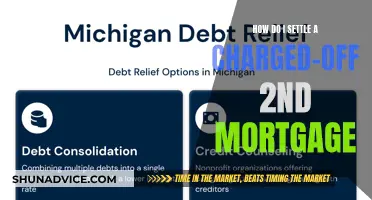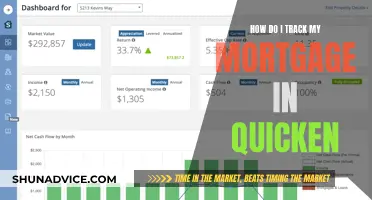
Removing your name from a joint mortgage is a significant step in organising your financial future. It is a common situation, so there are always solutions at hand. The most common way to remove someone from a joint mortgage is through refinancing the loan in the name of the person who will retain ownership of the property. However, this is not always possible due to financial constraints, credit issues, or lender restrictions. In that case, there are a few alternative paths to consider, such as a loan assumption, where one party takes over full responsibility for the mortgage with the lender's approval, or a loan modification, where the lender agrees to alter the loan's terms.
How do I remove my name off a joint mortgage?
| Characteristics | Values |
|---|---|
| Remove name from joint mortgage | Refinancing the loan in the name of the person retaining ownership of the property |
| Obtaining a new mortgage that pays off the existing one | |
| Loan assumption (one party takes over the full responsibility of the mortgage with the lender's approval) | |
| Loan modification (the lender agrees to alter the terms of the existing loan to accommodate the change in borrowers) | |
| Sell the property | |
| Partition action (a court order forcing the sale or division of shared property) | |
| Buyout (pay the other owner's share of the equity to take full control of the mortgage) | |
| Rent out the property | |
| Recruit a co-signer for the mortgage loan | |
| File for bankruptcy |
What You'll Learn

Refinancing
To refinance a joint mortgage, the remaining co-borrower must have acceptable credit, a debt-to-income ratio, equity, and income, as well as the consent of the person being removed. The process is similar to the original loan approval process, and the new lender may be cautious about refinancing with only one borrower, especially if the remaining co-borrower may struggle to make payments.
It is important to note that refinancing usually incurs closing costs of 2-5% of the loan balance. There may also be early repayment charges if you are still within the original deal period. The remaining borrower will need to demonstrate that they can afford the new mortgage terms, including covering any buyout costs and early repayment penalties, and that there is enough equity in the property.
If refinancing is not an option due to financial constraints, credit issues, or lender restrictions, there are alternative options to consider, such as a loan assumption or loan modification.
Minimizing Mortgage Principal: Strategies to Reduce Your Debt
You may want to see also

Selling the property
However, selling a jointly-owned property can be emotionally taxing, especially if the joint owners are former partners or spouses. It is important to carefully consider the decision to sell the property and remove a name from a mortgage. If the final selling price of the home falls short of the outstanding amount owed to the mortgage lender, the owners could find themselves liable for the difference.
Additionally, selling the home could create a new tax burden. Proceeds from home sales can be subject to capital gains tax. You probably won't owe capital gains tax if you're selling your primary residence and owned it for at least two years, but you still might if your earnings exceed certain thresholds. Up to $500,000 in profits is tax-exempt.
If the mortgage is underwater, you may have to opt for a "short sale." This is a property sale in which the net proceeds do not fully cover all the liens on the property. In less fortunate circumstances, your mortgage lender can sue you for the difference between the foreclosure sale proceeds and the remaining loan balance. This is called a "deficiency," but in many states, mortgage lenders can't come after you for this.
If you decide to sell the property, you will need to work with your lender to amend the mortgage terms and conditions to reflect the change in ownership structure. The lender's involvement ensures that the financial obligations and rights pertaining to the mortgage are correctly attributed to the new owner.
Re-amortizing Your Mortgage: A Guide to Refinancing Your Home Loan
You may want to see also

Partition action
If you are unable to refinance your existing mortgage, the lender might insist that you fully pay off the loan to take someone's name off the mortgage. This action will free you and any other co-borrowers or co-signers from the mortgage agreement. If you cannot pay off the loan, your only other options are mortgage refinancing or selling the property to settle the remaining amount.
If you are looking to remove your name from a joint mortgage, it is important to first understand the legal and financial implications. It is always recommended to seek legal advice from an attorney or a professional financial advisor to understand your options and make an informed decision.
Offering Private Mortgages: A Comprehensive Guide for Lenders
You may want to see also

Buy out the other party
If you want to remove your name from a joint mortgage, one option is to buy out the other party. This involves refinancing the mortgage under a single owner-borrower, which can provide a clean break and remove joint liability for the loan.
Firstly, it's important to check your title deeds and see how the ownership of the property is arranged. It will either be under a joint tenancy or tenants in common. Joint tenancy mortgages are simpler to buy out, as the property is split equally (50/50) between the owners. Tenants in common mortgages can be more complicated, as there can be more than two people listed as property owners.
Once you understand the ownership structure, you can work out the equity. This is the value of the property minus any outstanding mortgage debt. For example, if your property is valued at £350,000 and the outstanding mortgage is £150,000, the equity is £200,000. If you have a joint tenancy, you would split this amount equally, so the buyout amount would be £100,000.
After calculating the buyout amount, you'll need to apply for a new mortgage in your name alone. This process is similar to the original loan approval process and will require proof of income, credit history, and outstanding debts. Your lender will assess your financial situation to decide whether to approve the new mortgage.
Finally, once the new mortgage is approved, you can proceed with the buyout. This usually involves a lump-sum payment to the other party, encompassing their equity in the property. It's important to note that there may be early repayment charges associated with remortgaging, and you'll need to decide how these will be paid.
While buying out the other party can be a straightforward solution, it's important to consider the financial implications and ensure you can afford the monthly payments on your own. It's always a good idea to consult a lawyer or financial advisor when navigating complex financial matters like removing your name from a joint mortgage.
Removing Your Ex-Husband from Your Mortgage: A Step-by-Step Guide
You may want to see also

Seek legal advice
Seeking legal advice is a crucial step when navigating the complex process of removing your name from a joint mortgage. Here are some detailed instructions and considerations to guide you through this challenging situation:
Understanding Your Rights and Options
First, consult with a qualified attorney or solicitor specialising in property and mortgage law. They can help you understand your legal rights and outline the options available to you. This is especially important if you're dealing with a divorce or separation, as there may be specific legal procedures to follow. For instance, in Australia, financial separation under Section 79 of the Family Law Act 1975 may apply.
Refinancing the Mortgage
One common option to remove your name from a joint mortgage is through refinancing. This involves applying for a new mortgage in the remaining owner's name to pay off the existing one. The remaining owner will need to meet certain financial criteria, such as credit score, income, and debt-to-income ratio. Remember that refinancing can be a complex process, and your lender may have restrictions or conditions.
Loan Assumption and Modification
If refinancing isn't feasible, explore alternatives like loan assumption or modification. Loan assumption requires lender approval and allows one party to take over full responsibility for the mortgage. Loan modification involves negotiating with the lender to alter the existing loan terms to accommodate the change in borrowers.
Selling the Property
If all else fails, selling the property may be the most amicable solution. This allows both parties to maintain their equity in the property and move forward financially. If your co-borrower refuses to sell and other options are exhausted, you can consider a partition action—a court order forcing the sale or division of the shared property.
Protecting Your Finances
In cases of divorce or separation, it's crucial to protect your finances, especially if your former spouse or partner stops making payments. An attorney can guide you through this process and help safeguard your financial interests.
Remember that the specific legal processes and requirements may vary depending on your jurisdiction. Always seek personalised advice from a qualified legal professional before making any decisions regarding your joint mortgage.
Purchasing Mortgage Leads: A Guide for Beginners
You may want to see also







